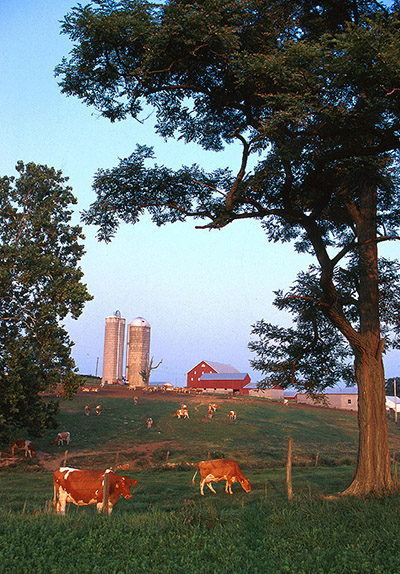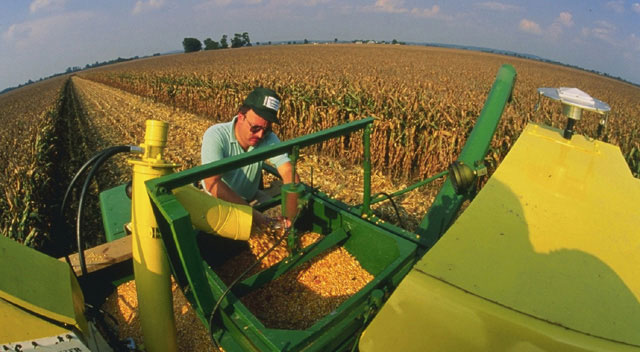Agriculture and climate: Connecting the science
USDA, NCAR team up to identify where nation is vulnerable, how we might adapt
Feb 19, 2013 - by Staff
Feb 19, 2013 - by Staff
Rachel Hauser • February 19, 2013 | With U.S. agriculture taking a massive hit from the widespread drought of 2012, farmers and other stakeholders are hungry for guidance on how crops may fare as the nation’s climate evolves over the coming decades. This year’s National Climate Assessment (NCA) includes new findings on agriculture and climate change—key science that draws from a longstanding collaboration between NCAR and the U.S. Department of Agriculture.
Pulling together the latest studies, researchers from the USDA, the university community, and nongovernmental organizations produced Climate Change and Agriculture in the United States: Effects and Adaptation. This newly released technical document explores the current effects of changing climate as well as projections of change that may occur over the next 100 years. Scientists from the USDA and collaborating organizations used the information from this report to write the NCA chapter on the effects of climate change on U.S. agriculture.

A small dairy farm in western Maryland. Changes in the number of days of extreme heat could affect dairy production in coming decades. (U.S. Department of Agriculture photo by Scott Bauer.)
The report marks the second time the USDA has worked closely with NCAR on a major climate analysis. The previous NCA, released in 2009, called on a variety of synthesis and assessment (SAP) products, including the widely used SAP 4.3, The Effects of Climate Change on Agriculture, Land Resources, Water Resources, and Biodiversity in the United States.
“We initially approached NCAR because of its reputation for climate knowledge and modeling capabilities, both of which broadened the perspective on current and future effects of climate change on U.S. agriculture,” explains Margaret Walsh, a senior ecologist with the USDA’s Climate Change Program Office, who oversaw the creation of both background reports. “As an added benefit, NCAR leveraged connections within the U.S. scientific community to work on both the 2008 and 2013 reports, which played an important role in the success of both efforts.”
Peter Backlund, director of NCAR’s Integrated Science Program, was a lead author on both reports. “Working with the USDA gives NCAR a great opportunity to bring our science to bear on real-world problems,” says Backlund.
The roots of the national assessments lie in the 1990 Global Change Research Act (GCRA), which created the U.S. Global Change Research Program to establish a better national understanding of global change. Part of this act requires U.S. federal agencies to assess the effects of human activities on the environment and to produce a national assessment of climate every four years. The NCA presents the latest details on the effects of climate change on the United States; U.S. federal agencies gather and compile the information that feeds into the NCA.
Toward this end, USDA focuses on how the nation’s agro-ecosystems will fare.
The 2008 SAP pulled together previously disparate information for the first time in a single document. The response from U.S. agriculture stakeholders—who range from farmers to participants in the agriculture industry to local, state, and national decision makers, as well as scientists and the public—has been overwhelmingly positive, says Walsh.
“We meet with stakeholders almost every week, and most come in with the SAP 4.3, talking about its conclusions as they relate to their interests,” Walsh says. “With the release of this new report, we are seeing similarly high levels of interest.”
Building on the earlier report, the authors of the 2013 technical document updated and expanded the breadth of SAP 4.3. They included issues not addressed by the 2008 report, honing in on the potential economic effects of climate change on U.S. agriculture and considering adaptation strategies.
Additionally, a variety of climate scenarios created by NCAR scientist Caspar Ammann provided insights on understanding climate’s influence on changes in seasonal length and timing of frost days—changes that affect plant germination and other factors considered in planning for the next growing season.

Agricultural engineer Kenneth Sudduth examines samples of grain collected by a combine. (U.S. Department of Agriculture photo by Bruce Fritz.)
“American farmers have a long history of adaptability—they’ve always adapted to changes in weather, consumer demand, soil requirements, and invasion of noxious weeds and insects,” says Charles Walthall, a scientist in the USDA’s Agricultural Research Service who led the team writing the 2013 technical report.
“However, climate change is now happening so quickly, presenting challenges previously not encountered by agriculture. These new challenges may make it harder than ever before for farmers, ranchers, land managers, industry, and government to adapt to changes as they occur. This reality made considering the question of what to expect and how to adapt important ones to address in this report.”
In essence, says Walthall, the document provides a synthesis of agricultural climate science that helps define the vulnerability of agriculture to the effects of climate change.
“The 2013 technical report offers the most comprehensive treatise to date on the topic of climate change effects on U.S. agriculture, and its contents will affect the priorities of future USDA research,” Walthall says.
The effects of climate change—physical, social and economic—and how to approach climate adaptation have become what Walthall calls “a rallying point,” both within the USDA’s Agricultural Research Service and in the broader agricultural research community.
“We were fortunate to have the benefits of NCAR scientists and their scientific network to help us merge cutting-edge climate knowledge with cutting-edge agricultural science. The results of this collaboration, as presented by the document, are expected to have lasting influence on choices made about U.S. agriculture,” says William Hohenstein, Director of USDA’s Climate Change Program Office.
USDA technical report: Climate Change and Agriculture in the United States: Effects and Adaptation